5. THE YOUNG REPUBLIC

GETTING STARTED
| CONTENTS
 George Washington takes the helm George Washington takes the helm
 Alexander Hamilton as Treasury Alexander Hamilton as Treasury
Secretary
 Thomas Jefferson as Secretary of State Thomas Jefferson as Secretary of State
 Foreign policy problems Foreign policy problems
 John Adams takes command (1797) John Adams takes command (1797)
 The "midnight" judicial appointments The "midnight" judicial appointments
 Life settles in nicely at home in the new Life settles in nicely at home in the new
Republic
The textual material on this webpage is drawn directly from my work
America – The Covenant Nation © 2021, Volume One, pages 174-191.
|
A Timeline of Major Events during this period
| 1780s |
The beginning of a period of major change ... in both America and France
1789 Washington inaugurated in New York as the first U.S. president (Apr)
The French Revolution breaks out (Jul)
spurred by the ideals of the Enlightenment ... and the example of the new American Republic
|
| 1790s |
The Republic struggles to establish new (and hopefully viable) political norms
early 1790s Mounting political feud rises in Washington's Presidential cabinet between Treasury
Secretary
Hamilton (Federalist) and Secretary of State Jefferson
("Republican"/strong states-righter), with
Washington generally supporting Hamilton (to Jefferson's great ire)
1790 Hamilton announces a new national bank’s "assumption" of all public debt (national and state);
Jefferson and his
political ally Madison are strongly opposed to this centralizing of
economic power
1791 Congress approves Hamilton's plan for a US Bank and the plan for central financing of the public debt
The states ratify 10 Constitutional
Amendments (Bill of Rights), guarantying key political protections against the
unlimited growth of central (or ‘national’) governmental power
1793 The French Republic has alienated all other European monarchies; all of Europe is again at war
The political hostility between
Hamilton (pro-British) and Jefferson (pro-French) deepens
Washington’s Proclamation of Neutrality is a rather pro-British position
"Citizen Genet" is welcomed by Jefferson as French
Ambassador but proves to be an unwelcome meddler in American politics
The Supreme Court under Chief Justice John Jay in the Chisolm v. Georgia case affirms that a citizen has the right to sue a state government in a federal court
1794 As an immediate reaction to the Chisolm case, the 11th Amendment is added to the Bill of Rights, affirming the immunity of
the states from such lawsuits (unless a state agrees to a hearing)
The French Republic dissolves into a state of unbounded political slaughter (the "Reign of Terror")
Massachusetts farmers rebel against
Hamilton's excise tax on their whisky production; Washington personally leads a
13,000-man army to swiftly crush the "Whiskey Rebellion"
The Jay Treaty seems to surrender
American maritime rights to the increasingly aggressive English
The cotton gin is invented, vastly
deepening the importance of slavery to the Southern economy
1796 Washington steps aside, serving only 2 terms (and glad to be going home to his farm), ... establishing a tradition
of a peaceful transfer of limited presidential power (to John Adams)
1798 French aggressions on the high seas lead arch-Federalists to want to go to war with France (and to political war with
the pro-French Jeffersonian Republicans ... with the Alien and Sedition
Act)
Adams agrees to a
treaty with the French, thus avoiding war, but getting him no gratitude
from the Republicans and costing him
the support of a number of arch Federalists (and re-election in 1800)
|
| 1800s |
The Federalist / Republican rivalry deepens
1800 The American capital is moved to Washington, D.C., a town mostly yet an ideal rather than a reality
Jefferson is narrowly elected President
(over Burr); Adams is humiliated by his loss
1801 As his last act in office, Adams signs the midnight judicial appointments, including John Marshall as Supreme Court Chief Justice; Marshall will greatly expand the powers of the Federal judiciary branch (1801-1835)
|
GEORGE WASHINGTON TAKES THE HELM |
|
Although the young American republic had a new Constitution, it was a
very slender affair outlining very little of what we have come to understand
today as government. That was just as well. Its brevity sufficed to bring
renewed unity to the competitive-minded states, and its vagueness in detail
left exactly just those details to be developed by the individuals who would
take their place as officers of the new republic.
George Washington
It was understood and expected by all (except
perhaps by Washington himself who, after the war, was looking forward to
ending his public duties and heading back to his farm at Mount Vernon to
enjoy a less frustrating set of labors!) that the person to lead the republic as
its new president was to be George Washington. After some soul-searching
he once again yielded to the call of duty when it was apparent that no one
else but he was expected to be the country's new leader. Thus on April
30th, 1789, he stood on the balcony of Federal Hall in New York City to take
the oath of office as the republic's first president.
How would he handle the office? There were a multitude of problems
facing the new Republic, none of them particularly military (at least for the
moment) and so his sole experience as a military officer would not give
much indication as to how he would handle the challenges of civil office.
The Constitution mentions only that a president is chosen for a four-year
term, but elected officials in the colonies could be, and frequently
were, repeatedly returned to office with a new election. Would he leave
after serving only four years? Would he want to stay on repeatedly, like a
monarch, ruling until he drew his last breath? Some bitter Anti-Federalists
even claimed that Washington would try to make himself king – although
those who knew him well were quite aware that this would have been the
last thing Washington would have wanted for himself.
In any case, how would he get things started as
president? What kind of legacy would he leave for others to live up to
and develop?
The answer came quickly as he gathered together a
small group of advisors to whom he could assign particular functions, a
group or council similar to the British royal cabinet. Although the
Constitution mentions no such institution, Washington, and all
presidents after him, chose to make very important use of a cabinet of
officials, some serving as personal advisors and some serving as heads
or secretaries of government institutions that American presidents have
long used to administer the office of president.
|
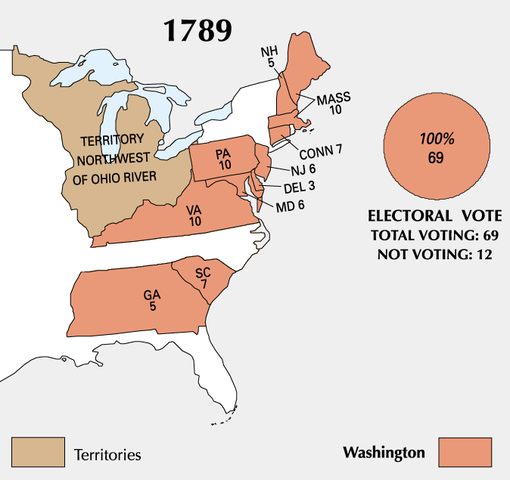
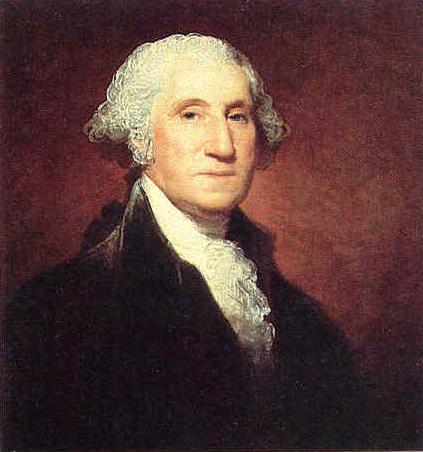
George Washington – by Gilbert
Stuart
National Portrait Gallery
- Smithsonian Institution, Washington, D.C.
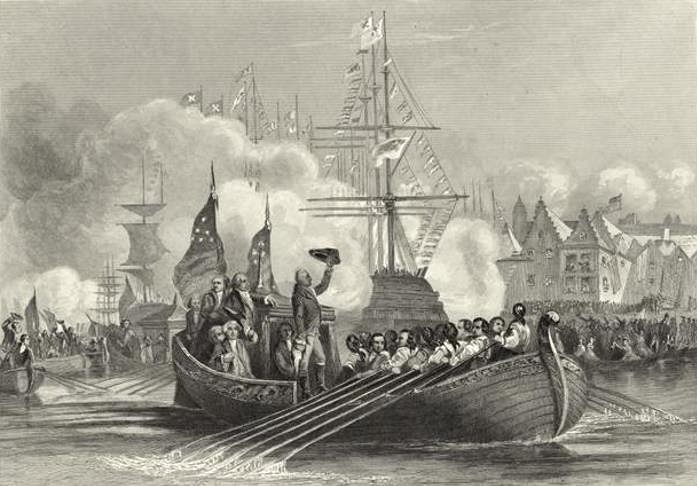
Washington receiving a naval salute upon his arrival at New York City
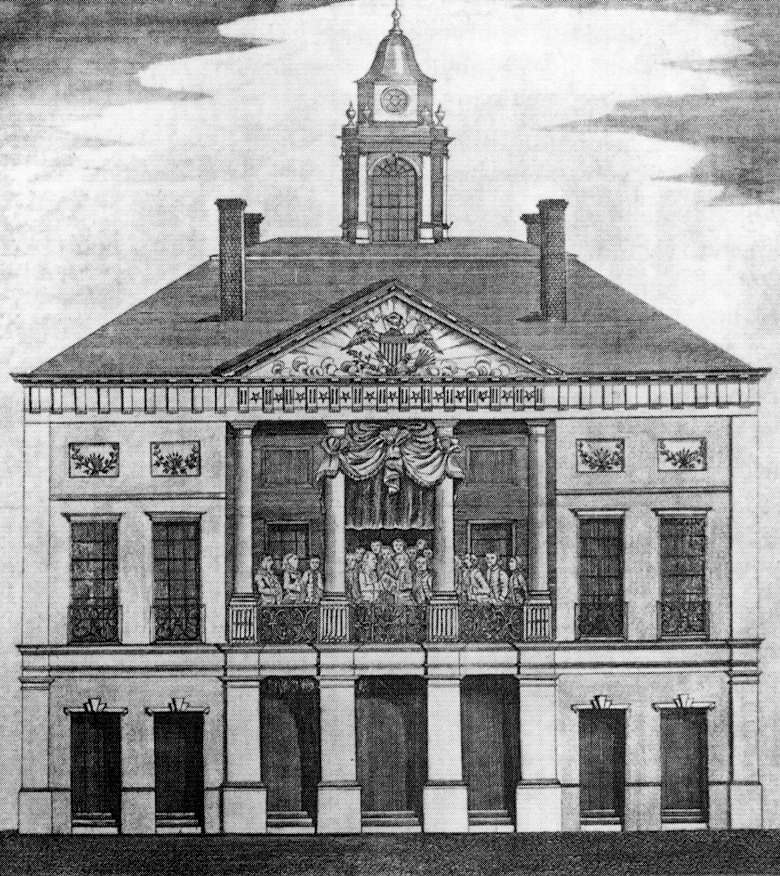
Washington takes the Oath of Office (April 30, 1789)
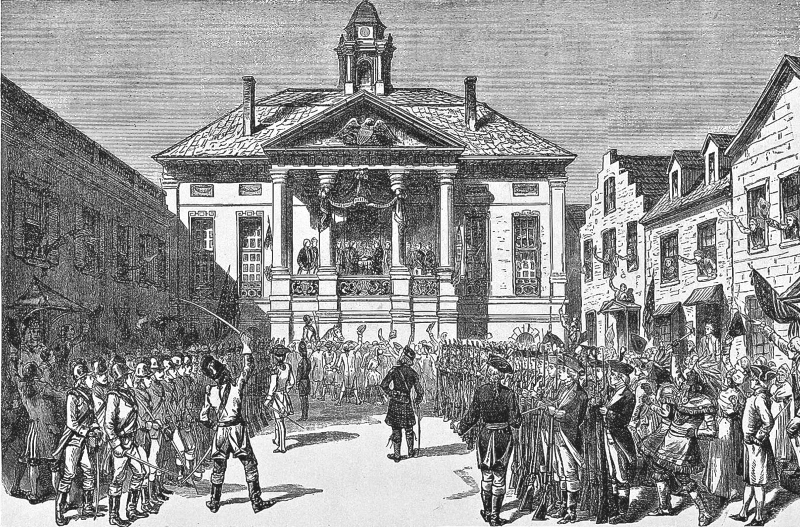
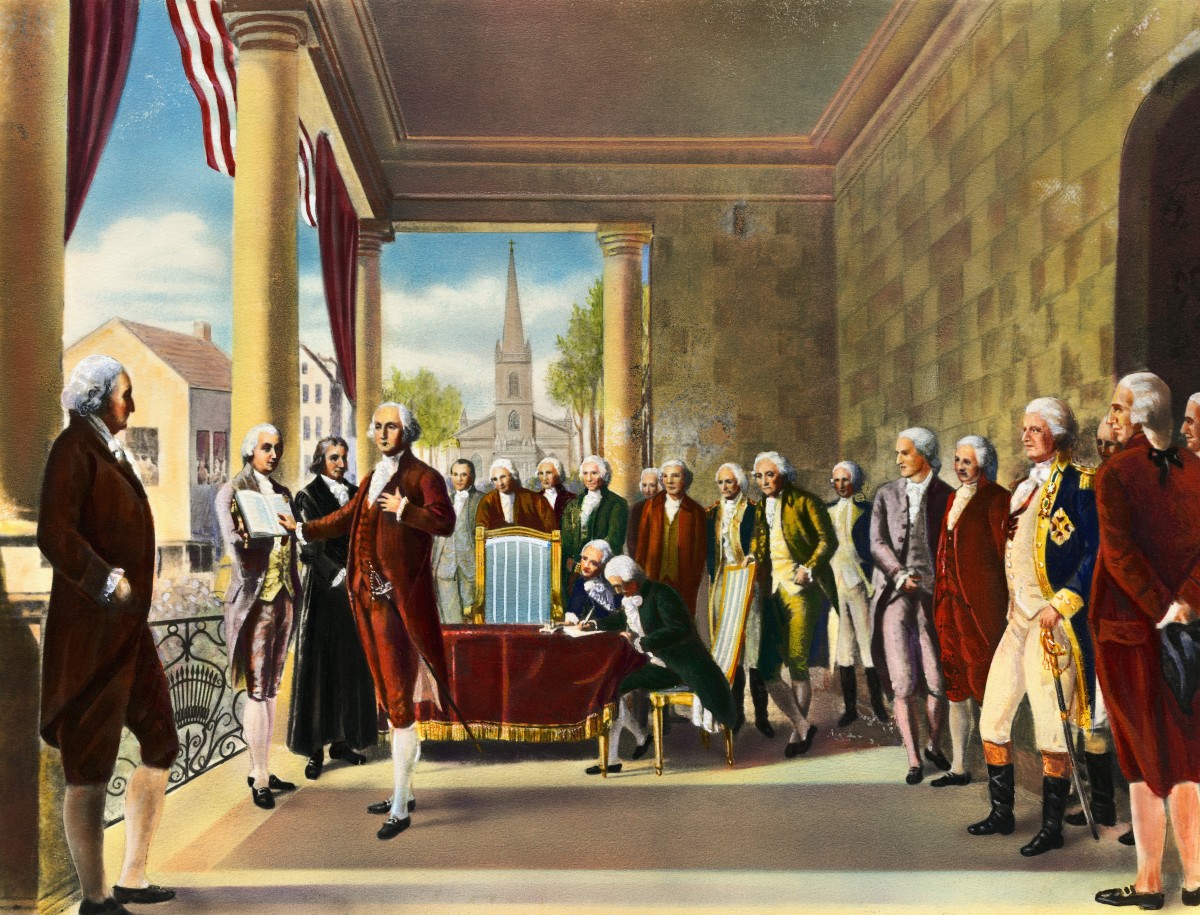
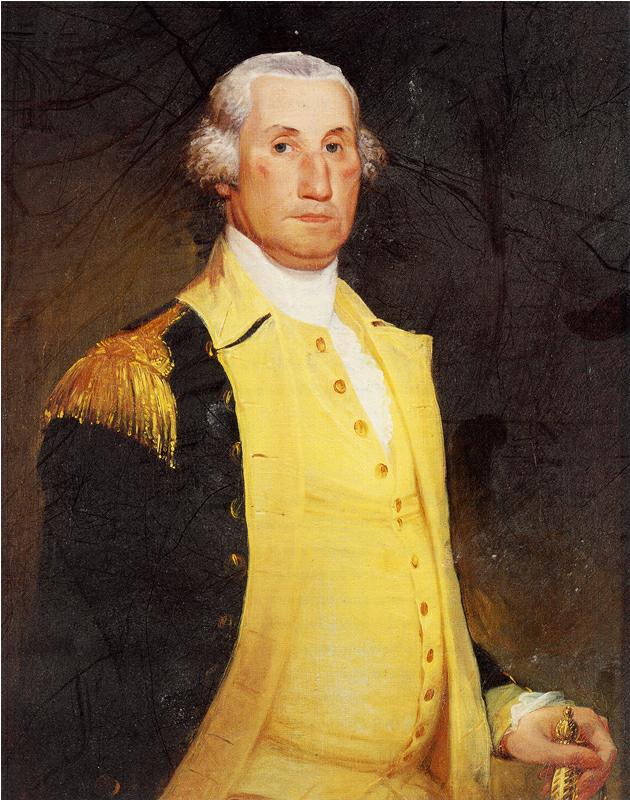
George Washington – by Joseph
Wright (both portrait and profile)
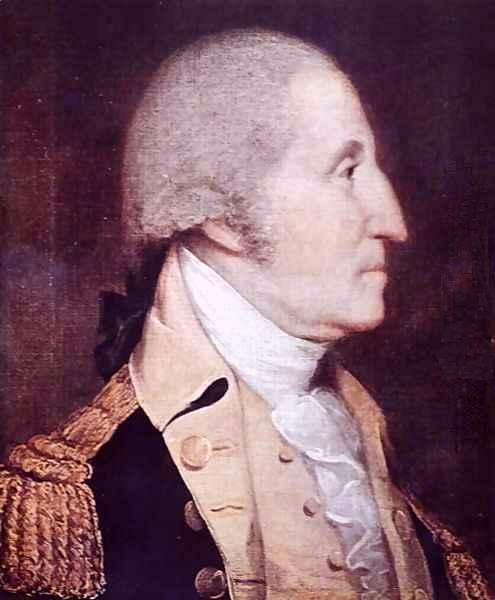

Washington's Cabinet
ALEXANDER HAMILTON AS TREASURY SECRETARY |
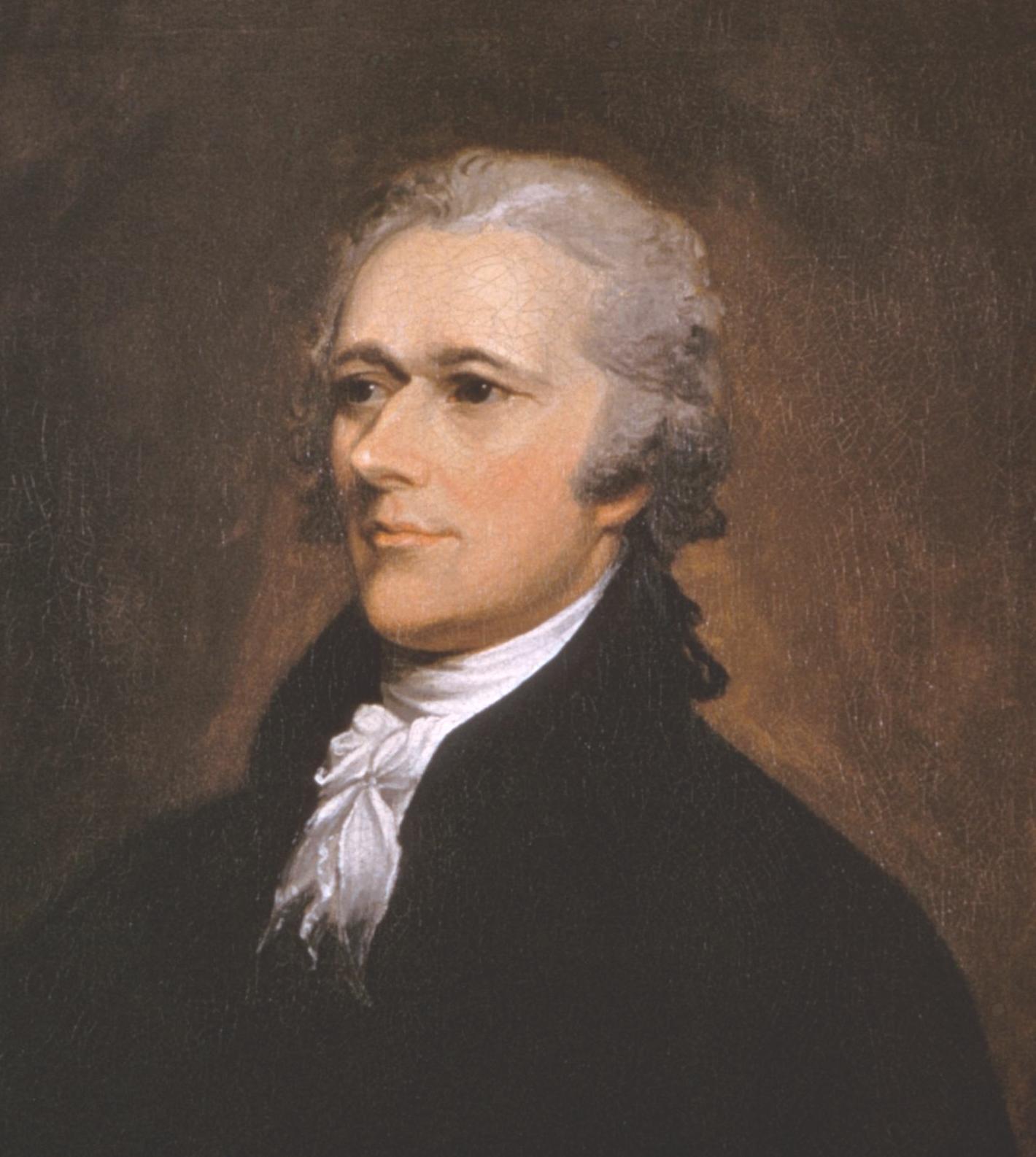
Alexander Hamilton – by John
Trumbull (1806)
National Portrait Gallery
- Smithsonian Institution, Washington, D.C.
|
Alexander Hamilton
Once
again, Washington called on the one person he trusted most for hard
work and natural brilliance of mind (and bravery), the one person he
had relied on, time and time again, in the years of the War: Alexander
Hamilton. With the financial status of the new republic being the new
Union's biggest challenge, Washington was quick to assign Hamilton as
the United States' first secretary of the treasury.
Hamilton was actually born (year uncertain) not in
one of the American colonies but in the Caribbean, under peculiar
family circumstances (that would be the object of much commentary by
his later political enemies) and was forced to look after his own
survival at a very early age.1 But he was a very avid reader,
bi-lingual (English-French), and a self-educated apprentice clerking
for a local merchant (possibly his actual father), and at seventeen
wrote an essay published in the local newspaper. The essay was
sufficiently impressive that it led local community leaders to gather a
fund to send Hamilton off to New Jersey in 1772 for formal education
(prep school). In 1773 he began his studies at King's College (Columbia
University) in New York, where he quickly distinguished himself as an
excellent orator supporting the colonies' growing spirit of rebellion
against British royal authority. Hamilton also wrote at the same time a
number of outstanding articles and essays in support of the same cause.
Yet he was also of a cautious or fair mind
(perhaps because of his own sufferings as a youth) and in May of 1775
came to the defense of the college president, allowing the man to
escape an angry mob, while Hamilton challenged the mob not to attack
Loyalists or their cause in this manner.
However, Hamilton was himself quick to take up
arms and join with friends in the New York militia, undertaking at the
same time (again, on his own initiative) the study of military history
and military tactics – and soon put that knowledge to use in leading a
raid on a supply of British cannons in the Battery! He then went on to
organize his own artillery company, elevating himself thereby to the
rank of captain. His company soon joined with Washington's troops in
the various battles that raged across New York City, and then across to
New Jersey, where his artillery kept the Hessians under fire at the
Battle of Trenton.
His talents were quickly recognized, and he was
asked by various generals to join their staff. Yet he understood that
glory was to be found on the field of battle, not on the general staff
of a commanding general ... that was until Washington made the same
request. That was an offer that Hamilton was willing to accept. And
this changed his life, and America's, forever.
As chief of staff he was assigned the task of
maintaining written communications with the Continental Congress, the
governors of the new states, and with other generals. Over the course
of four years, as Washington's confidence in Hamilton became virtually
total, Hamilton himself issued detailed military instructions to
officers under Washington's command, and supervised both diplomatic and
intelligence operations coming from Washington's command. Thus it was
that he met French General, the Marquis de Lafayette, and became close
friends with him in the process.
Finally at Yorktown, Hamilton's long desire to
actually serve directly under fire, came into play – with Washington's
very hesitant permission! It was Hamilton himself who led the American
attack on one of the two vital redoubts still holding the British line
in the latter's desperate defense at Yorktown. It was a brave, but
probably very foolish, move on Hamilton's part. But he obviously
survived, adding even more to his enormous stature in the eyes of
Washington.
After the war he formed a law partnership with a
friend and found himself, among other things, defending Tories who were
suffering from the post-war anti-British backlash, typical of his sense
of fairness. But he was nonetheless very interested in seeing his new
Republic move forward into its own distinct future, and thus in 1784
founded the Bank of New York, the beginning of his entry into the world
of large-scale financing.
He was as interested in the political future of
the country as its financial future and two years later attended the
Annapolis Convention, drafting the resolution which called for the
Constitutional Convention that eventually produced the U.S.
Constitution. The next year he became an assemblyman in the New York
State Legislature, which sent him as one of its three representatives
to the Convention in Philadelphia. And of course it was he who wrote
most of the articles that formed the famous Federalist Papers, advocating the adoption of the new Constitution.
Washington had not forgotten Hamilton and the
military service he had performed for him. He knew Hamilton to be
intensely loyal personally, intensely brave, intensely intelligent,
intensely competent, and intensely dedicated to serving his newly
independent country. And so it was that Washington turned to Hamilton
to see what Hamilton could do to help him put the new country on a
strong financial footing. Thus he asked Hamilton to become his
secretary of the treasury.
Hamilton's debt assumption program
As it
had always been during the war, one of the biggest problems facing
Washington and the struggling young Republic he was expected to lead
was money. Always money! By war's end, the Continental Congress had run
up a $54 million debt, and the states an additional $25 million. Also,
the promissory notes or bonds issued during the war by the Continental
Congress, by the various states, and by the army had been bought up by
speculators after the war at fifteen cents on the dollar. Most people
believed that they were not worth even that much. In other words, the
creditworthiness of the Republic was almost nil.
Hamilton however had some well-developed ideas as
to how he wanted to meet that challenge. He proposed to Congress
(January of 1790) a method of clearing the debt by what he called
assumption: the federal government would assume all of the debts and
begin the process of repaying them – at full value! America would pay
its debts. The world could take confidence in that. It was indeed
financial confidence that Hamilton was trying to restore. To meet this
obligation, the Republic would itself borrow (issuing its own
promissory notes or bonds) to cover the debt through bonds issued by a
newly created national bank: the Bank of the United States (BUS).
Besides financing the repayment of the national debt, principally
through heavy taxes on imports, the BUS would also fund public economic
infrastructure projects and private industrial investment for national
development.
1His
mother was married but separated from another man when she met and
married (thus illegally) James Hamilton, Alexander's presumed father.
When her legal status was brought to light, James left her and young
Alexander. Then when Alexander was only thirteen his mother died,
leaving Alexander an orphan.
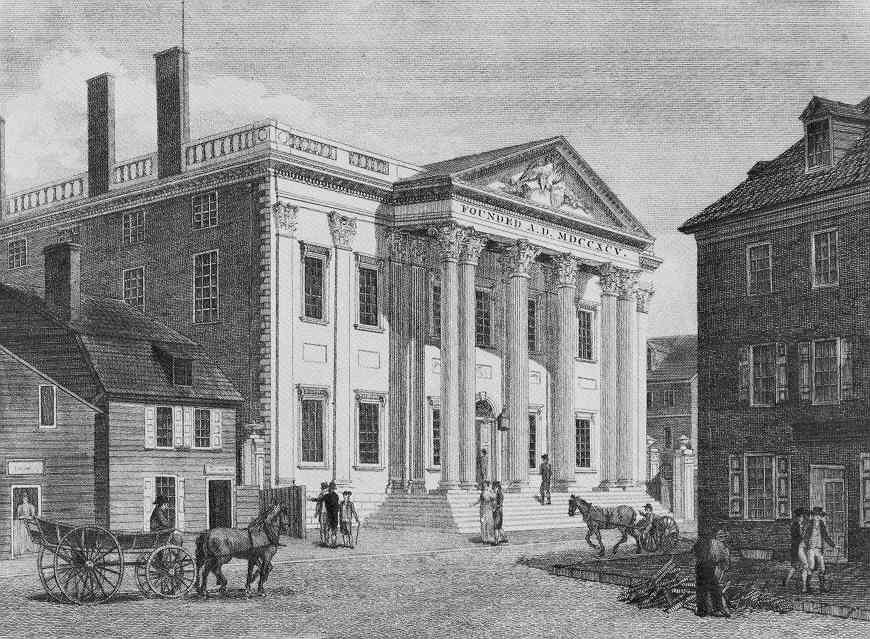
The first Bank of the United
States – Philadelphia
Library of
Congress
| Hamilton's
program was designed to found the nation not on the democratic whims of
the masses but the hard-nosed realism of the moneyed class that
commanded the American economy. Understanding the mind-set of America's
moneyed class, Hamilton planned to involve this class in the new
government by inviting wealthy financiers to exchange the old
Continental Congress's bonds with the Republic's new bonds. This would
give these individuals a very strong financial interest in seeing the
new government succeed. And, most importantly, it would place the new
government's finances on very strong foundations.
Money is power. And the new nation needed power in
order to survive in a very competitive world. Strong financial
foundations were absolutely essential for a Republic trying to
establish itself as a serious, viable institution in a very challenging
world.
But the reaction to his proposals was swift. The
heart of the reaction was this matter of great principle found in the
personal debts hanging over the Patriot foot soldiers during their
wartime service (loans or mortgages for their homes and land they owed
various banks), when they were in no position to meet or pay down on
those debts. After the war they had returned to civilian life only to
find that those debts had gr own even larger while they had been away in
the army. Worse, they had been paid for their wartime services with the
almost worthless notes issued by the Continental Congress. They
retrieved what value they could by selling these notes to speculators
for whatever they could get, never enough however to meet the heavy
financial obligations hanging over them. And now, here was Hamilton
paying those speculators full value for these notes bought on the cheap
from penniless citizens. This all seemed very unfair, sort of a double
slap in the face of America's small heroes.
And there was also the irritation of the states
such as Virginia, which had paid off its own debts in full. Why should
they be part of a program assuming the debt of the states that had not
done what they had done?
There was a lot of anger that arose over Hamilton's
program. Jefferson's friend Madison was most vocal in his indignation
at Hamilton's idea of debt assumption because it seemed to be
developing at the heart of the federal system a power center on the
order of the royal tyranny America had just freed itself from.
Madison's strong stand eventually pushed Jefferson into an
ever-stronger States-Rights (or Anti-Federalist) position. And it cost
Hamilton his friendship with Madison, who as a former Federalist, now
turned into an equally dedicated organizer of an Anti-Federalist group
headed up by his fellow Virginian, Jefferson.
As it turned out, Washington threw his support
behind his treasury secretary and Congress moved ahead to approve
Hamilton's program. And indeed, it did put the new Republic on fairly
firm financial footing. But it had opened a wide political wound
between the Federalists and Anti-Federalists that would not be healed.
As Madison himself had forecast (and in the Federalist Papers had
justified as necessary to the proper functioning of a representative
government) America took its first steps toward a two-party political
system: Hamilton's Federalists in competition with Jefferson's
Anti-Federalists, who under Madison's tutelage would organize
themselves as the Republicans (not related to the modern Republican
Party)
|
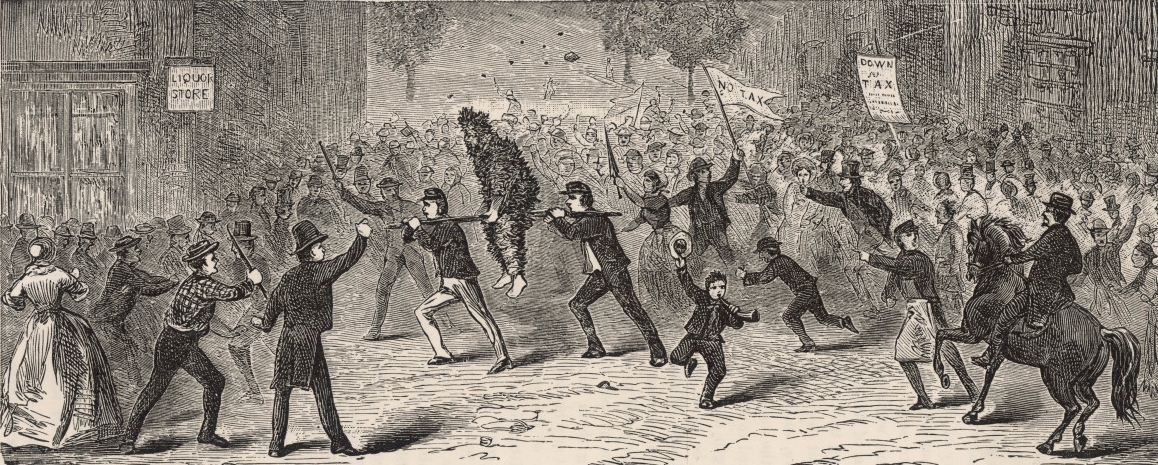
One of Hamilton's federal revenue collectors being tarred and feathered by irate farmers
during the Whiskey Rebellion in Pennsylvania (1791-1794)
|
The Whiskey Rebellion of 1791-1794
But
paying off that debt was proving to be highly difficult. When Hamilton
had raised import duties as high as he felt he could go before it would
start crippling American business, in 1791 Hamilton placed an excise
tax on the production of whiskey, a basic essential in the diet of the
American farmers – and also a means of currency in the farmers'
businesses. Understandably, the new tax met with the same resistance
that had George III's 1773 tea tax imposed on his American subjects to
pay for his wars. Westerners from upstate New York, through Western
Pennsylvania, into Ohio and Kentucky, Western Maryland and the Western
Carolinas all got increasingly involved in the refusal to submit to
Hamilton's tax.
Complicating matters was the fact that Eastern
distillers could be much more efficient in the massive production and
local distribution of their product and thus proportionately much less
burdened by the excise taxes than the frontier farmers. Consequently,
Eastern distillers offered no objection to the new tax. However, this
differing situation facing the Eastern producers and the Western
farmers merely added to the enormous frustration of the latter group.
Washington, however, agreed with Hamilton that the
toleration of the insubordination in the West would collapse the
authority of the Republic. It was a hard thing to do to come up against
these strong souls, many of whom had fought alongside Washington in the
War of Independence, a war that had had similar roots in its resistance
against George III's new taxes.
But ultimately the question was not about taxes
(for a government cannot operate without an income stream of some kind)
but about the legality of those taxes. The Republic needed everyone
involved in the support of their new government, not just the business
and financial classes of the Eastern cities, in order for the Republic
to succeed and not fail.
And finally, just as in the need to maintain
discipline in a war-time army, the Republic would fail in peace-time
unless it too could get compliance to its laws, laws properly or
legally instituted and properly enforced. Lack of political discipline
would certainly destroy the Republic.
Events going on in Paris (the French Reign of
Terror, 1792-1794) at that very same time were making this matter quite
clear. Street mobs had taken control of the effort to birth the new
French Republic and it was looking increasingly likely that the French
Republic was thus going to fail in its efforts to get itself
established. Now the very same threat seemed to hang over the young
American Republic at this point.
Thus in August of 1794 Washington led a 13,000-man
army into Western Pennsylvania to confront protesters (who quickly
melted away at the appearance of Washington and the army). The show of
force broke the rebellion. The authority of the Republic's government
was thus confirmed.
But ultimately, the event only deepened the
distrust by the rural Westerners (and Southerners) of the moneyed class
of up-East Federalists.
The Kentucky Question
This event and the
growing regional distrust would register itself clearly in the form of
a dispute when Kentucky applied for statehood. The up-East Federalists
dragged their feet, fearing they would be overwhelmed in Congress by a
growing Southern/Western coalition lined up against them. Finally a
compromise was reached in 1791 when New England's Vermont was admitted
to the Union, opening the way in 1792 for Kentucky to be admitted as a
new state as a counterbalancing principle in the politics of statehood,
a principle that would be applied again and again as the country
struggled over deep cultural differences that separated the various
regions of the country.
|
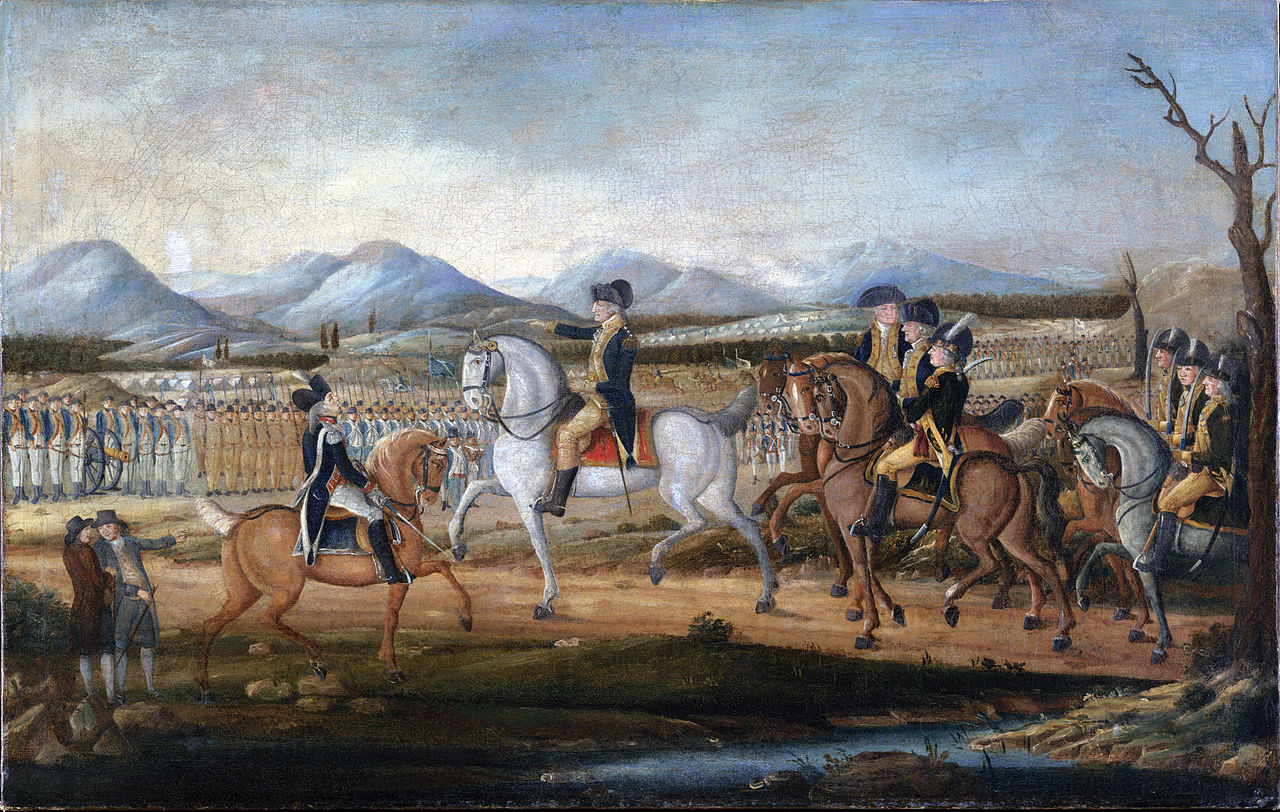
Washington leading his troops to put down the Whiskey Rebellion (early October 1794)
Washington undertook this unpleasant task ... because he didn't want America to fall into disorder
... the kind that was destroying France at about the same time.
THOMAS JEFFERSON AS SECRETARY OF STATE |
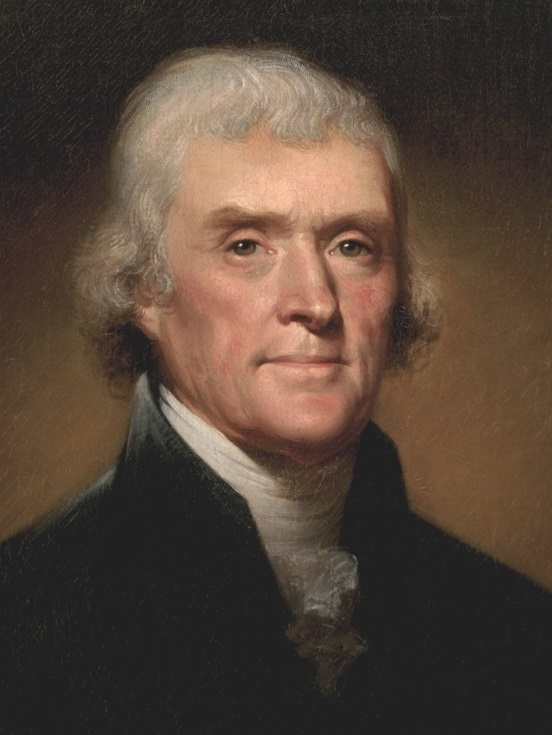
Thomas Jefferson – by Rembrandt
Peale
White House Historical
Association
|
Thomas Jefferson
Washington
had appointed Jefferson to his cabinet as his secretary of state,
charged with overseeing America's diplomatic missions abroad and
(supposedly) advising Washington on foreign policy matters as the need
arose. Jefferson would not be easy to work with.
Jefferson was born to a Virginia planter family,
with important family ties – especially on the side of his mother, Jane
Randolph, a cousin of Peyton Randolph, who was a leading political
figure of Virginia during the 1760s and early 1770s.2 At an early age
Jefferson was tutored along with the Randolph children, and as a youth,
in classic aristocratic fashion, he was taught Latin, Greek and French,
along with history, science and the classics. At age sixteen he entered
the College of William and Mary, where he continued his study of these
same disciplines. He graduated two years later to begin his study of
law under the prominent George Wythe. And at age twenty-one he
inherited 5,000 acres and fifty-two slaves from his deceased father's
estate, including the land where he would begin the building of
Monticello, the place of perfect habitation developed from his own
ideal design.
He was admitted to the Virginia bar in 1767 and as
a practicing lawyer represented his county as a delegate to the House
of Burgesses (1769-1775). In 1772 he married a third-cousin, Martha,
and settled into a period that was perhaps the happiest of his life. In
the ten years of their marriage she bore him six children, only two of
which survived to adulthood.3 They also inherited from her father
another 11,000 acres and 135 slaves to work the land, but also a heavy
debt that accompanied the title.
When he was sent to represent Virginia at the
Second Continental Congress in 1775, he befriended John Adams. And thus
he was invited to join the committee assigned the task (supposedly
Adams's responsibility) of drafting a Declaration of Independence, the
startup version which was ultimately assigned to Jefferson. Some
changes were subsequently made to Jefferson's draft by the committee,
then by the full Congress (as we have already noted, about a fourth of
the whole was cut out, including a section connecting King George and
the slave trade!).
At the time, the Declaration seemed to be a much
less significant matter than all of the new state constitutions being
drafted by the thirteen newly independent states!
Shortly after this (September of 1776), he was
elected to the new Virginia House of Delegates. Here he served on the
committee working on the new Virginia Constitution, and sponsored the
Bill for Establishing Religious Freedom, forbidding state support of
religious institutions or doctrines – which however failed to pass. Two
years later he was given the responsibility of reviewing and editing
Virginia's system of laws. And the year after that (1779) he was
elected as the state's governor, undertaking at that point to institute
new laws in pursuit of his personal worldview concerning religion,
education, property rights, etc.
When in 1781 Benedict Arnold, at that point
serving the British, attacked the new Virginia capital at Richmond,
Jefferson and members of the Assembly were able to escape to Monticello
(Richmond was burned to the ground). Then when Cornwallis approached
Monticello, they escaped from there to another of his plantations to
the West.4
After the war (1783) he became a delegate to the
Confederation Congress where he chaired the committee that drafted the
1784 Land Ordinance, removing the Northwest Territories from the
on-going land title conflicts among the states by making them
territories eventually eligible to become states of their own. Also,
slavery was to be outlawed in these territories.5
In 1784 he was sent to join Franklin and Adams in
Europe in the effort to negotiate trade agreements with England, France
and Spain (Franklin returned to America the next year). Jefferson
quickly (1785) made himself at home among the French, befriending the
Marquis de Lafayette in his effort to develop improved trade relations
between the U.S. and France.
He also fell in love with the French lifestyle
(including its wine and books). Then soon after the French Revolution
broke out in July of 1789, he returned to Virginia, intending however
to return soon to Paris. But the request by Washington to serve as his
new secretary of state (charged with the responsibility of supervising
the country's diplomatic mission) caused him to remain in America.
But this would bring him into direct contact with
Hamilton, a man whose views Jefferson by instinct opposed on virtually
every front. Hamilton was very supportive of a strong central
government, able to unify the functioning of the thirteen states,
politically as well as economically. This Jefferson opposed strongly,
fearing that such a strong central authority would compromise greatly
the states' rights to conduct their own affairs as they chose. He was
thus highly opposed to the concept of a national authority (until he
himself later became president of that very nation!).
Furthermore, unlike the almost spiritual rapport
that existed between Washington and Hamilton, Jefferson and Washington
lived in very different universes when it came to foreign policy and
diplomacy. Even though Jefferson was supposed to be in charge of the
conduct of foreign policy, it was usually to Hamilton that Washington
turned rather than to Jefferson when faced with a foreign policy issue
needing to be resolved. Jefferson grew increasingly resentful over
this.
A big part of the problem was that Jefferson was
by nature an intellectual who lived in a world of perfect plans and
grand schemes. He was also personally smitten by French culture and had
become deeply involved in the Enlightenment dreams of the French
intelligentsia that eventually took over the French Revolution – and
drove it to the human butchery of the 1793-1794 French Reign of Terror.
And Jefferson, even though saddened by the gruesome excesses of French
Republicanism, refused to admit that there was any injustice in how
these cruel events were unfolding in France. A greatly self-blinded
Jefferson was quite certain that 99 percent of the Americans supported
strongly, even gladly, the events going on in France. Thus despite the
carnage, he convinced himself that it was France that needed America's
total support in the ongoing English-French conflict.6
Hamilton and Washington, on the other hand,
despite the recent war with their English cousins, still considered
England as America's best partner when it came to the contests
involving European politics and economics, which seemed always
unavoidable, especially to such a trading people as the New England
Yankees.
There really was no way to side-step the ongoing
French-English conflict, and neither France nor England would let
America get away with being merely neutral in the struggle. One way or
the other, America would constantly have to choose sides, not usually
happily, whatever the choice. And in choosing sides it usually ended up
pitting Hamilton and Washington against Jefferson (and Madison).
Jefferson grew increasingly furious about how
Washington was lining up behind Hamilton and the pro-British
Federalists and in December of 1793 resigned his position on
Washington's cabinet. From then on, he and his Republicans would be
active opponents of Washington and his Federalist cabinet.
|
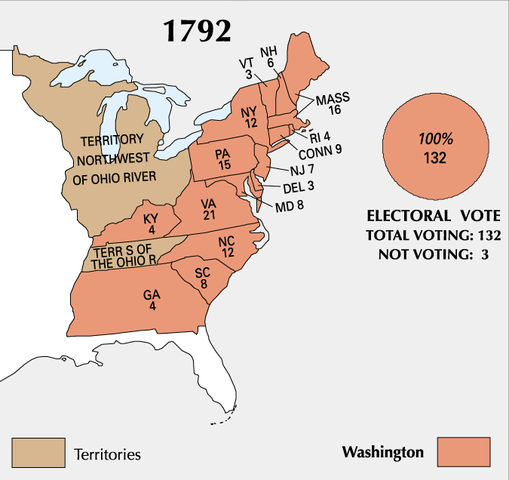
Washington's re-election as U.S. President in 1792
2Randolph
was speaker of the Virginia House of Burgesses (1766–1769), was the
president of the First Continental Congress (1774) and president of the
Virginia Convention debating independence from Britain (1775, just
before his death that year).
3Already sick from diabetes and her frequent childbirths, she died in 1782 at age thirty-three in delivering their sixth child.
4It
was later that year decided by the Assembly that Jefferson had acted
appropriately. But he had lost such stature that he was not reelected
governor.
5His
anti-slavery provision was not approved at the time, though
reintroduced and subsequently approved when the ten territories were
consolidated into five territories, the future states of Ohio, Indiana,
Illinois, Michigan and Wisconsin.
6When William
Short, a Jeffersonian supporter, wrote Jefferson from Paris that mobs
had taken over the French Revolution and had executed some of their
French friends, Jefferson in early January of 1793 wrote back a sharp
rebuke: "The liberty of the whole earth was depending on the issue of
the contest, and was ever such a prize won with as little innocent
blood? My own affections have been deeply wounded by some of the
martyrs to this cause, but rather than it should have failed I would
have seen half the earth desolated; were there but an Adam & Eve
left in every country, & left free, it would be better than as it
now is."
|
The Citizen Genêt Affair
This
Federalist-Republican conflict came clearly into public view in
1793–1794 when the new French Republic sent Citizen Edmund Charles
Genêt to America as its diplomatic representative. Jefferson was
enthusiastic in receiving this polished Frenchmen.
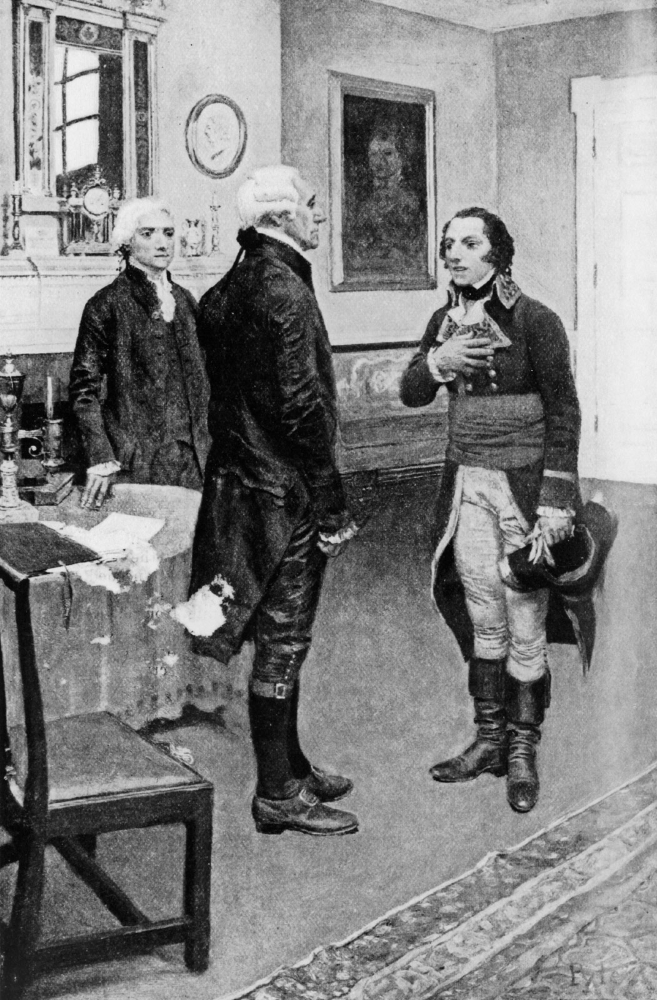
Genêt presenting himself to Washington upon his eventual arrival to Philadelphia.
Then the
problems began. Genêt treated America as if it were a poor
step-child. When Washington declared America neutral in the
French-English war, Genêt began to go around the authority of the
president, maneuvering in different ways to involve America in the war
on the French side. Genêt disregarded all diplomatic protocol by
setting up Americans to attack English and Spanish positions in
Florida, Louisiana, and Canada, even hiring privateers to attack
American shipping heading toward England! Washington was
furious. And at this point even Jefferson and Madison were ready
to back away from him.
In any case when in 1794, during the French Reign of
Terror, the extremely radical Jacobin Party began executing not only
"enemies of the Revolution" but also the rival revolutionary (though
less radical) Girondist Party, of which Genêt was himself a member,
Genêt himself realized that he was now a man on the run.
Washington was gracious enough to grant him asylum, and Genêt spent the
rest of his days quietly in America!
Jay's Treaty (1794)
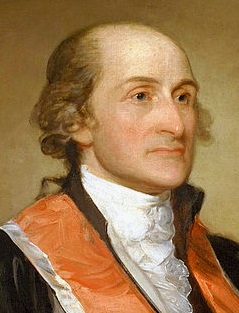 Despite the formal signing of the 1783 Treaty of Paris marking the end
of the American War of Independence, the British had been disregarding
the specific terms of the agreement as if they had never existed. The
British had failed to pay the promised compensation to slave owners
whose slaves the British had freed during the War. But America had also
failed to keep its promise to compensate American Tories who lost their
property when they fled to Canada during the War. In any case, the
British continued to occupy their forts in the Western territories, and
even allied with Indian tribes to block the spread of the American
settlers into those territories.
Despite the formal signing of the 1783 Treaty of Paris marking the end
of the American War of Independence, the British had been disregarding
the specific terms of the agreement as if they had never existed. The
British had failed to pay the promised compensation to slave owners
whose slaves the British had freed during the War. But America had also
failed to keep its promise to compensate American Tories who lost their
property when they fled to Canada during the War. In any case, the
British continued to occupy their forts in the Western territories, and
even allied with Indian tribes to block the spread of the American
settlers into those territories.
But what was most disturbing was the high-handed way the
British impressed sailors by boarding American ships and seizing
sailors they claimed were simply their sailors who had deserted to the
easier life under sail in America. In fact, many of these sailors
pressed into British naval service were simply the hardiest looking
American sailors, and not British at all. To try to get the British to
ease up on impressment and to honor the terms of the Treaty of Paris,
Chief Justice John Jay was sent in 1794 to London to negotiate a better
working relationship with the British.
But America was in a distinct position of having to negotiate
from weakness, at a time when the British were more focused on winning
the on-going struggle with the French than on making Americans happy.
As a consequence, Jay returned from England with a new treaty ("Jay's
Treaty" as it was scornfully termed) that seemingly offered America
very little. The idea of Britain compensating the American slave owners
for their property loss was dropped (infuriating the Southerners) and
America agreed to accept limited trade rights as neutrals in exchange
for the British to finally vacate themselves from the American West.
Although Jay could not have extracted anything more from the British
than what they had agreed to in this new treaty, Americans of all
political shades were outraged. Even Washington came under abusive
attack in the press for his acceptance of the treaty.
After a bitter debate in Congress, the treaty was approved
(barely) by the necessary two-thirds vote in the Senate. But
Jefferson's Republicans, holding a strong voting position in the House
of Representatives, were determined to block the appropriations
(spending) necessary to bring the treaty to full force. Discussions in
the House dragged on for months, with both England and France lobbying
representatives to vote up (the British) or down (the French) the
necessary legislation. In the end (by a majority of only three votes)
the House approved the appropriations bill backing the treaty.
But the emotional price paid for passage had been very, very
high. Jefferson's Republicans had lost no opportunity to slander the
Federalists as pro-monarchist because of their pro-British sentiments.
The Republicans awarded themselves the title of true Republicans
because of their support of the French Republic, Americans not yet
having realized, or at least not having been willing to acknowledge,
the brutality of events in Republican France. The American Republicans
were totally supportive of the French Republic's devotion to spreading,
quite violently, anti-monarchical – and often even anti-church -
Republicanism to the rest of the civilized world. Thus Hamilton was
greatly slandered by the Republican press for his pro-monarchist
loyalties (but he was actually not at all a pro-monarchist, as his
actions in the recent war had clearly demonstrated), because he was not
willing to join with the Republicans in their enthusiasm for what was
going on in France. That was a cheap political shot aimed at Hamilton
by the Jeffersonian faction. But Washington was slandered no less for
the same reason!
But the press campaign was very effective. It marked the beginning of
the decline of the Federalist Party.
|
JOHN
ADAMS TAKES COMMAND (1797) |
|
Washington refuses to take on a third term as president
Washington had originally agreed to serve only one term as president
(1789-1793), but had been prevailed upon to run for a second term in
the approach to the 1792 elections. He grudgingly accepted the request.
But now in 1796, as he approached the time for the elections for a
third term in office, he made it very clear that under no circumstances
would he continue to serve as president once his second term in office
ended in early 1797. He was tired of the bickering between the
Federalists and the Republicans and wanted simply to go home to his
farm at Mount Vernon. Washington was thus more than willing to oversee
a smooth handover in power to his successor, which in this case was his
vice president, John Adams.
And so it was that Washington set the
constitutional tradition that two terms in office was something of a
limit to presidential service. America would not be saddled with a
president-for-life, as so frequently happens in new republics.
7President
Franklin Roosevelt, however, would run for a third and even fourth term in the
1930s and 1940s using the emergency of the World War (Two) as
justification for doing so. But Washington's "two-terms-only"
presidential tradition was ultimately confirmed as a Constitutional
Amendment (the Twenty-Second) in 1951.
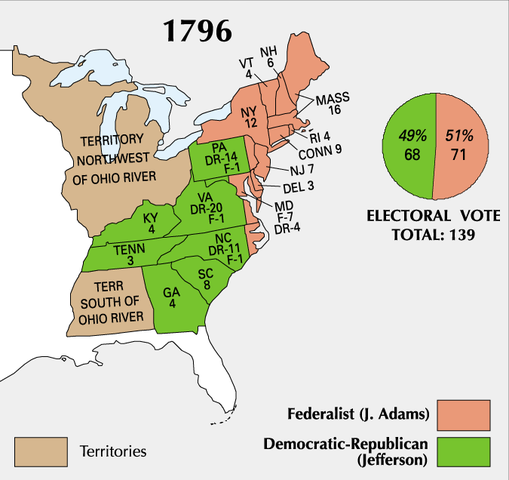
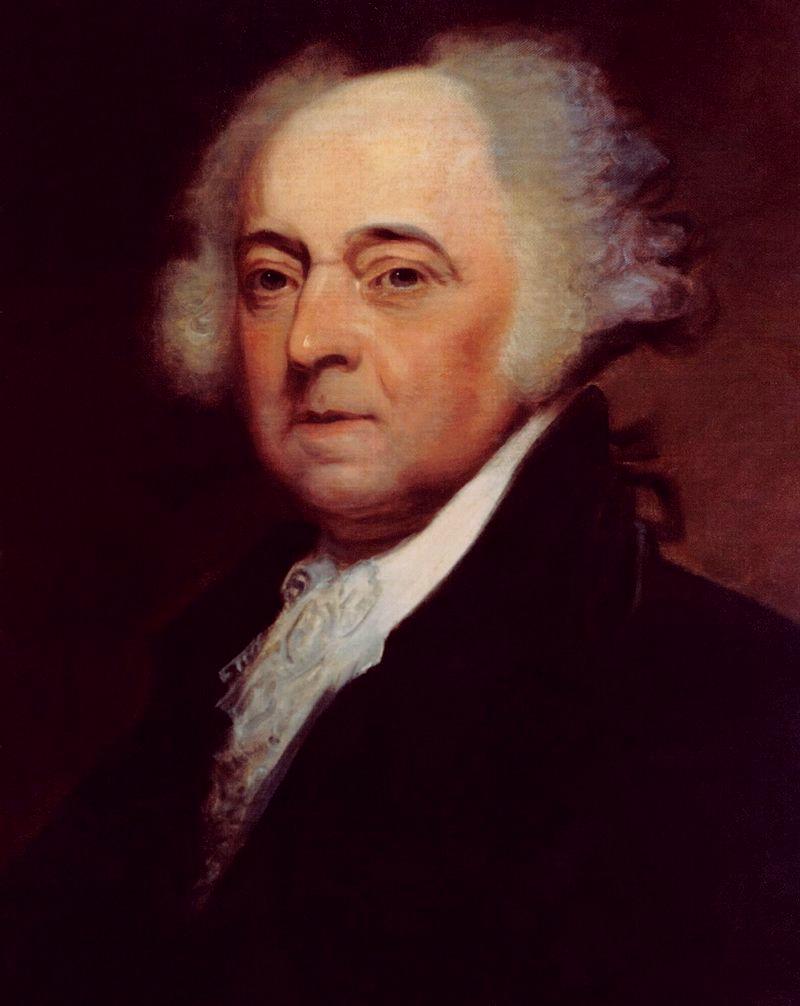
John
Adams – 2nd President of the United States – by Gilbert Stuart
National Gallery of Art
|
John Adams
Although Adams was a staunch Federalist, he was very
sensitive to his own place in the scheme of things politically and
socially, and found himself frequently at odds with not only Jefferson
and his Republicans, but also Hamilton, who after Washington, was the
strongest figure among the Federalists. A man of high moral principle,
Adams unfortunately was lacking in the tact necessary to put those
principles to use without raising a lot of powerful opposition. Sadly,
he went largely unappreciated in his own days and by his own people for
the way he helped follow up Washington's lead in bringing the country
to even greater stability and security – at a time when huge dangers
still swirled around the young Republic.
Adams had grown up in a small Massachusetts town
to a family that held strongly to the original Puritan beliefs and
ethics, stressing basic human equality in God's (and thus man's) eyes,
the importance of working to achieve rather than merely inheriting
one's place in life, and the critical nature of personal integrity, no
matter the possible social cost for living true and honestly. Also in
typical Puritan fashion, there was an early emphasis in his family on
the importance of formal education which Adams began at age six, then
continuing into Latin School, and at age sixteen entering Harvard
College.
But he disappointed his father when he dismissed
any ideas of becoming a minister and graduated from Harvard instead as
a teacher, pondering the question (that he faced most of the rest of
his life) of how to become great. This of course put him in conflict
with his sense of Puritan morality, a conflict that he would never
successfully resolve.
Law nonetheless seemed to offer the best path to
the greatness that he so eagerly sought. Thus he clerked for a
prominent local lawyer and in 1758 received his master's degree from
Harvard and was soon admitted to the bar. Eventually his legal work
would draw him into the cause against growing royal authority in the
colonies, for which he began to write (anonymously) in the Boston
newspapers.
In 1764 he married a third-cousin and preacher's
daughter, Abigail, and proceeded to have six children in fairly rapid
succession (the last however did not survive birth), the second born
(and first son) being the future president, John Quincy Adams.
Adams came to public attention when in 1765 he published a letter sent
to the Massachusetts legislature concerning the highly controversial
Stamp Act, restating in very clear and compelling terms the rights of
Englishmen concerning both taxation and judicial treatment by the
authorities. This helped to bring about his election to public office
as a representative on the town council.
In 1768 he moved his family and law practice to
Boston. But his law practice did not come into prominence until he
defended the British Redcoats accused of murdering members of the
Boston crowd who had been taunting the soldiers. He claimed that he
feared that this might damage his reputation. But instead it helped him
to gain a Boston seat on the Massachusetts legislature three months
later and a considerable increase in his law business.8 Seemingly Adams
had finally found his path to greatness. But this came amidst growing
chaos in Boston, and in 1774 Adams moved his family back to the family
farm in Braintree – permanently.
However, he continued his work in Boston in the
thick of a darkening war cloud. He delivered a hallmark speech in the
legislature challenging the British governor with the claim that
Massachusetts had always been self-governing; that its charter was only
with the King, not Parliament; and that the colonies would have no
other recourse if Massachusetts' rights were not respected by British
authorities than to take the road of full independence from Britain.
These ideas were then extensively developed in a publication that
clearly outlined the legal arguments behind them. At this point Adams
had secured a very prominent position in the growing debate.9
Quite naturally Adams was sent by his state as one
of its representatives to the First and Second Continental Congresses
(1774 / 1775-1777). At first he was looking for ways to bring Britain
and the colonies back into a better relationship. But seeing no
flexibility coming from London, he soon found himself working hard to
convince his colleagues that full independence was the only path at
that point open to the colonies. And in mid-1775 he was the one who put
forward the name of Washington as the one to lead the colonial army
gathering around Boston (a careful move to secure Virginia to the
cause). In 1776 he got confirmation from Virginia with that colony's
Resolution joining the cause, and was subsequently appointed to head
the committee assigned the task of drafting a Declaration of
Independence. Jefferson wrote most of the draft, but it was Adams who
guided its passage through the Continental Congress.
Soon after this, Adams was sent with Franklin to
hear the terms that General Howe was willing to offer after a series of
defeats of Washington's army in New York. But the discussions led
nowhere when the American representatives showed no sign of
compromising on their decision for full independence. Adams was now a
hunted man (on the list of treasonous colonials who would have been
shown no mercy if the rebellion had finally been put down by the
Redcoats).
During the next couple of years Adams worked
tirelessly on a number of committees backing the war effort, learning
important administrative procedures through his extensive service to
the cause. Then in 1778 he was appointed (along with Franklin and
another American) to represent the new United States in negotiating a
treaty of alliance with France, then returning home – only to be sent
back the following year to begin discussions in Paris with British
representatives to work out some kind of peace terms (Adams in the
meantime developing some fluency in the French language!).
Adams was a contentious person (as he himself well
knew) and did not find it easy working with Franklin, whose well-staged
homespun manners that so attracted the French Adams himself detested
with equal vigor. Nonetheless, the British (especially after the
humiliation at Yorktown in 1781) were gradually willing to back down
and acknowledge American independence, and work out the compromise
(land rights to the West and compensation for civilian property losses
on both sides of the conflict) that eventually led to the Treaty of
Paris in 1783.
In the meantime, Adams had been appointed
ambassador to the Dutch Republic (1780), securing that country's
recognition of American independence in 1782 and also securing from
Dutch banks valuable loans needed to help the American states get on
their feet after the war. With peace at hand, Adams was appointed in
1785 as America's first ambassador to the English Court of St. James,
where he sincerely sought to restore friendship between the
English-speaking peoples on both sides of the Atlantic. Here in London
he put together another written work, defending the new U.S.
Constitution just after its adoption in Philadelphia in 1787. Though
not as famous as the Federalist Papers, it was itself a very clear
definition of how in a republic a system of checks and balances among
different branches of the people's government was essential to keeping
power operating safely within the bounds that the designers of the
Constitution intended.
When elections for the presidency of the new
Republic were held in 1789, Adams came in second behind Washington in
the count, thus by the understanding of the times becoming the nation's
first vice president. But with this, Adams disappeared from public
view, as was typical of those called to that office. Washington never
drew on Adams' services, never consulted Adams on any issue. This left
Adams resentful against Hamilton whom the president frequently
consulted and even against the president himself whom he visibly
supported but for whom he developed a personal dislike. But at least
the office put him in something of a position to be the heir-apparent
to the presidency when Washington indicated in 1796 that he definitely
was retiring from public service.
But Adams was going to have to face Jefferson and
his alliance of mostly Southern Republicans, plus the question as to
whether or not Hamilton would put his Federalist support behind Adams
(he did, because Hamilton despised Jefferson more than he disliked
Adams!). In the end Adams narrowly defeated Jefferson with his
seventy-one electoral votes to Jefferson's sixty-eight votes, the
voting being almost entirely a northern versus southern state electoral
division. Thus Adams became the nation's new president, and Jefferson
(being in second place) became the nation's vice president.
The XYZ Affair
Troubles with Europe
continued to rock American politics as Adams assumed his presidential
office. But it was now France's turn to play the role of seizing
American vessels, hundreds of them. Jefferson and his pro-French
Republicans were embarrassed into silence over this French arrogance.
As for Hamilton and his pro-British wing of the Federalists, they
jumped at this opportunity to demand a declaration of war against the
French.
Adams sent a delegation to Paris in 1797 to try to
find a remedy to the problem. But the delegation was met by French
agents X, Y and Z, who demanded bribes and a loan before the Americans
would be allowed to meet with French foreign minister Talleyrand. The
Americans refused and returned to the U.S., with the news of the "XYZ
Affair" stirring even greater war fever among the indignant Federalists
under the slogan, "millions for defense, but not one cent for tribute!"
8Analysts
determined that he had skillfully selected just the right jury members
(many of whom later became pro-British Loyalists), and that from that
moment the outcome of the trial was a foregone conclusion (six soldiers
were acquitted and two convicted of the lesser crime of manslaughter).
9However,
his more flamboyant cousin Samuel Adams was at the time even more
prominent – having led the Boston Tea Party dumping tea in the Boston
harbor in 1773!
|
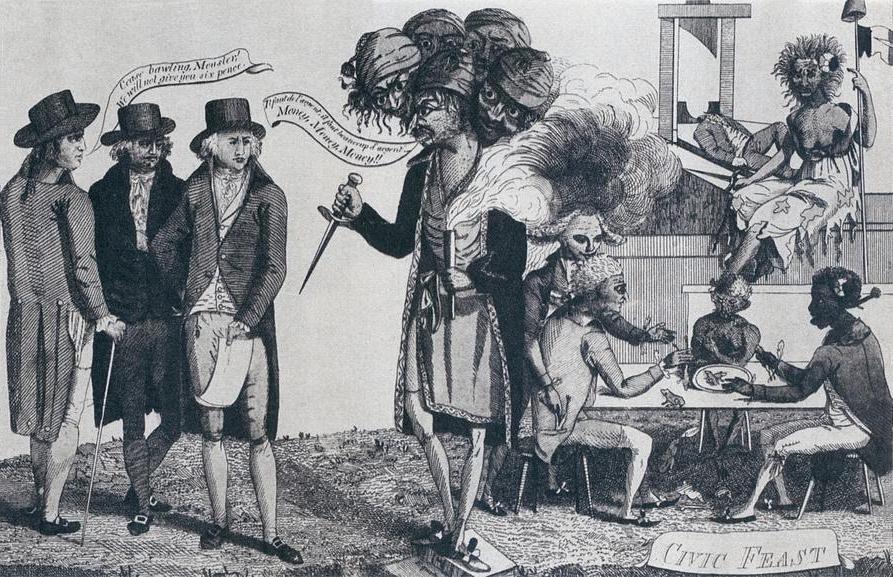
A cartoon showing American envoys in Paris (October 1797)
refusing to pay bribes to unnamed French agents X Y and Z
|
The Alien and Sedition Acts (1798)
But this then raised among
nervous Federalists the specter of pro-French treason at home (not too
subtly aimed at their Republican rivals). In 1798 the Federalist
majority in Congress rushed through to passage four Alien and Sedition
Acts (which Adams unfortunately signed into law) empowering the
president to deport pro-French traitors and to penalize any pro-French
seditious language that might come from (Republican) newspapers and
public speakers. In the end all this succeeded in doing was drive the
Republicans even deeper in their resolve to oppose the Federalists at
all costs.
The doctrine of nullification
The strongly
Republican Southern and Western states of Virginia and Kentucky, in
bitter reaction to these Acts, passed their own Resolutions (authored
by Jefferson and his ally Madison) affirming that Congress had no
constitutional right to intervene in the internal affairs of the states
and their people. As the Constitution was the product of the action of
the states (or so the Republicans claimed anyway), it was the states,
not Congress, that had the last say in what was constitutional and what
was not. The states were the ultimate sovereign authority within the
Union, not Congress. The states thus reserved for themselves the power
to nullify acts of Congress which they regarded as being
unconstitutional.
This constitutional issue, of course, would be a
matter that would continue to be hotly debated until it finally led to
full civil war in the mid-1800s.
The Quasi-War with France
A conflict boiled over early in 1799 when America's new navy found itself fighting with France on the high seas. Fired up by a major sweep in the 1798 elections (thanks to the XYZ affair), Federalists now pressed harder for a declaration of war against France. Finally Adams took matters in hand to solve this issue tearing the country apart, and sent envoys to Paris to negotiate an improvement in U.S.-French relations. In a resultant treaty, the French agreed leave American shipping alone, thus bringing the "quasi-war" to an end.
The treaty did not at all please the Hamiltonian
Federalists, nor did it suffice to restore for Adams friendly relations
with the Jeffersonian Republicans. But he signed the treaty anyway,
suspecting that by doing so it would end his political career. Indeed,
one month later, during the 1800 presidential elections, Adams was
voted out of office, having served only one four-year term. And thus it
was that Adams had given up the presidency in order to bring the
country back from the brink of war.
|
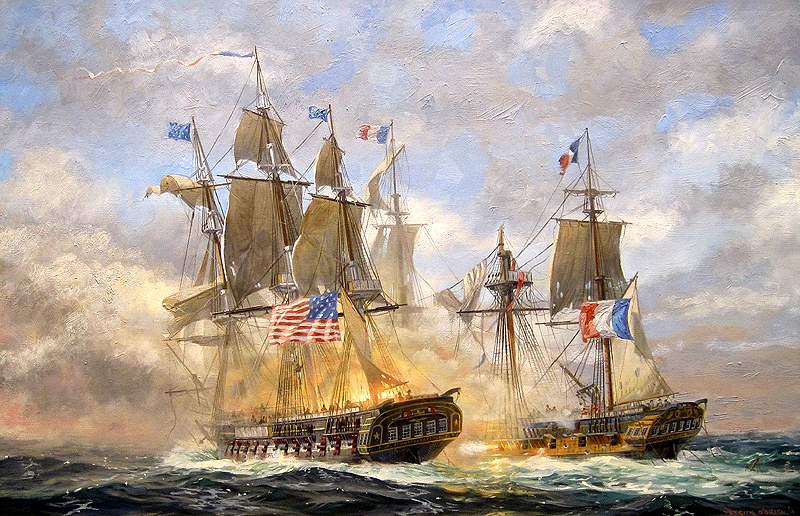
The American Constellation fighting and defeating the French L'Insurgente (February 9, 1799) during the "Quasi War" (1798-1801)
THE "MIDNIGHT" JUDICIAL APPOINTMENTS |
|
Interestingly, the very
last act of his presidency would be the one thing of his presidency
that would come to have lasting constitutional value: the creation by
Congress and appointment by Adams of individuals to some six dozen
judicial posts, including the fateful appointment of the Virginian John
Marshall as chief justice of the Supreme Court.
These mostly new positions resulted from
Congress's recent Judiciary Act of 1801, which expanded the number of
Judicial posts (which indeed were too few to handle the large caseload
before them), an act that was rushed through a lame duck10 Congress of a
majority of Federalists, many of whom had just lost the federal
elections to a new Jeffersonian Republican majority, but had a few
weeks of time remaining in office before the newly elected Congress
could take its place in the new capital city of Washington, D.C.
(actually at this point a forlorn collection of shacks, muddy lanes,
and farm animals!). In fact the job was so rushed that Adams spent his
last night in office completing the task of making these judicial
appointments, thus earning them the reputation from the Republicans as
the "midnight judges."
With this last act of public service completed,
Adams quietly slipped away from the capital to his home in
Massachusetts, a rather tired and bitter old man. He hadn't even
bothered to stay long enough to see the new president of the United
States, his once close colleague but now strong political rival
Jefferson, sworn into office.
But once again, the simplicity of this procedure
would demonstrate that in American political culture, defeat in an
election meant not a prolonged challenge to the results by a resentful
loser, but a peaceful transfer of power to the winner. It had been that
way since the founding of the Anglo-American society in the early
1600s, and would continue as an important political tradition into this
new era of Republican government.
10The
term "lame duck" refers to office-holders who have been voted out of
office in an election that went against them, but who still hold the
office for a brief period until the newly elected officials can take
their place. A lot of frantic legislation is often passed by a lame
duck assembly, realizing that it is about to lose power to its
opponents.
11That
important principle however seems to have been abandoned in the 2016
election, which brought the Republican Trump to the White House.
Democrats not only went to the streets in loud protest over the
results, but Democrat congressmen/women supported by a very Liberal
press corps began immediately to look for grounds to impeach Trump for
having committed "high crimes and misdemeanors" – and would stay
completely focused on that effort for years thereafter. And four years
later, Trump supporters would return the favor in their physical attack
on Capitol Hill when Trump lost the 2020 presidential election to
Biden. This is Third World politics, typical of what happens in
elections (should they even have them) in Asia, Africa and Latin
America. For America this has constituted a grand departure from
America's great constitutional tradition.
LIFE SETTLES IN NICELY AT HOME IN THE NEW REPUBLIC |
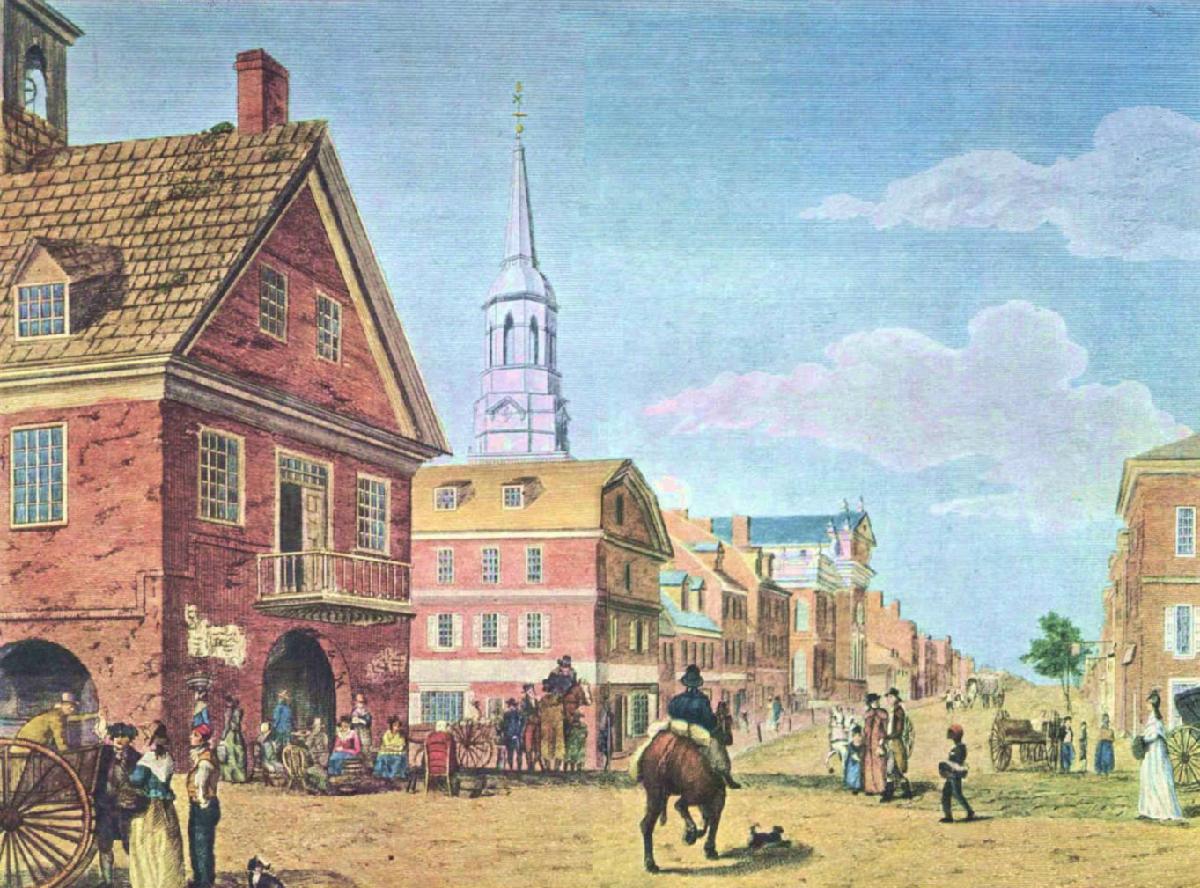
Philadelphia -
1799
Historical Society of
Pennsylvania
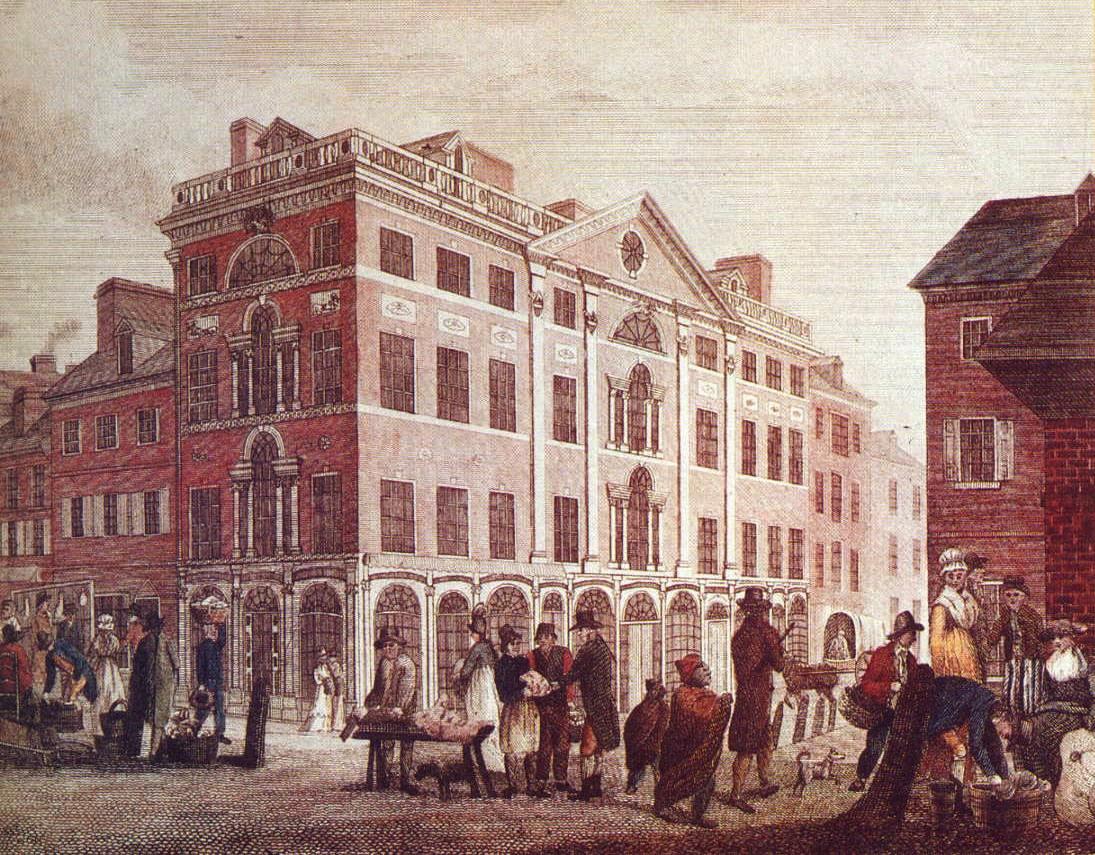 Philadelphia street scene
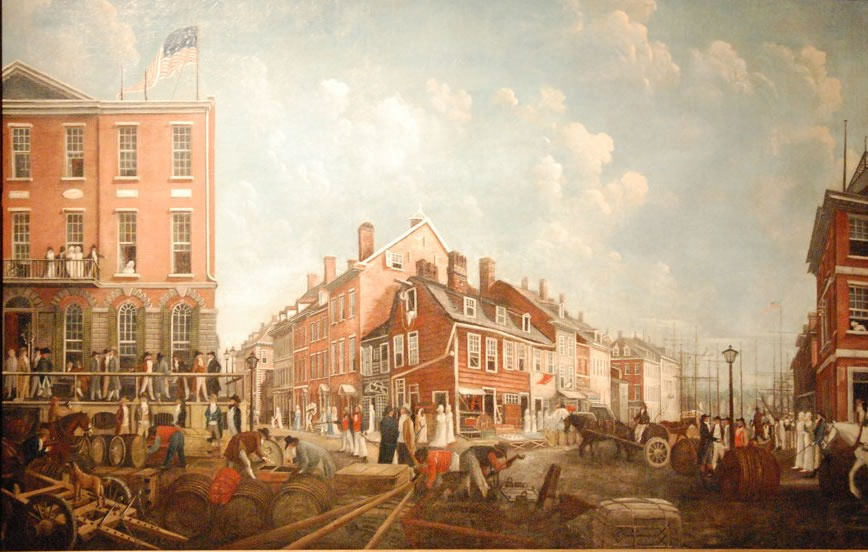
Tontine Coffee House in New York City – (around 1797)
New York Historical Society
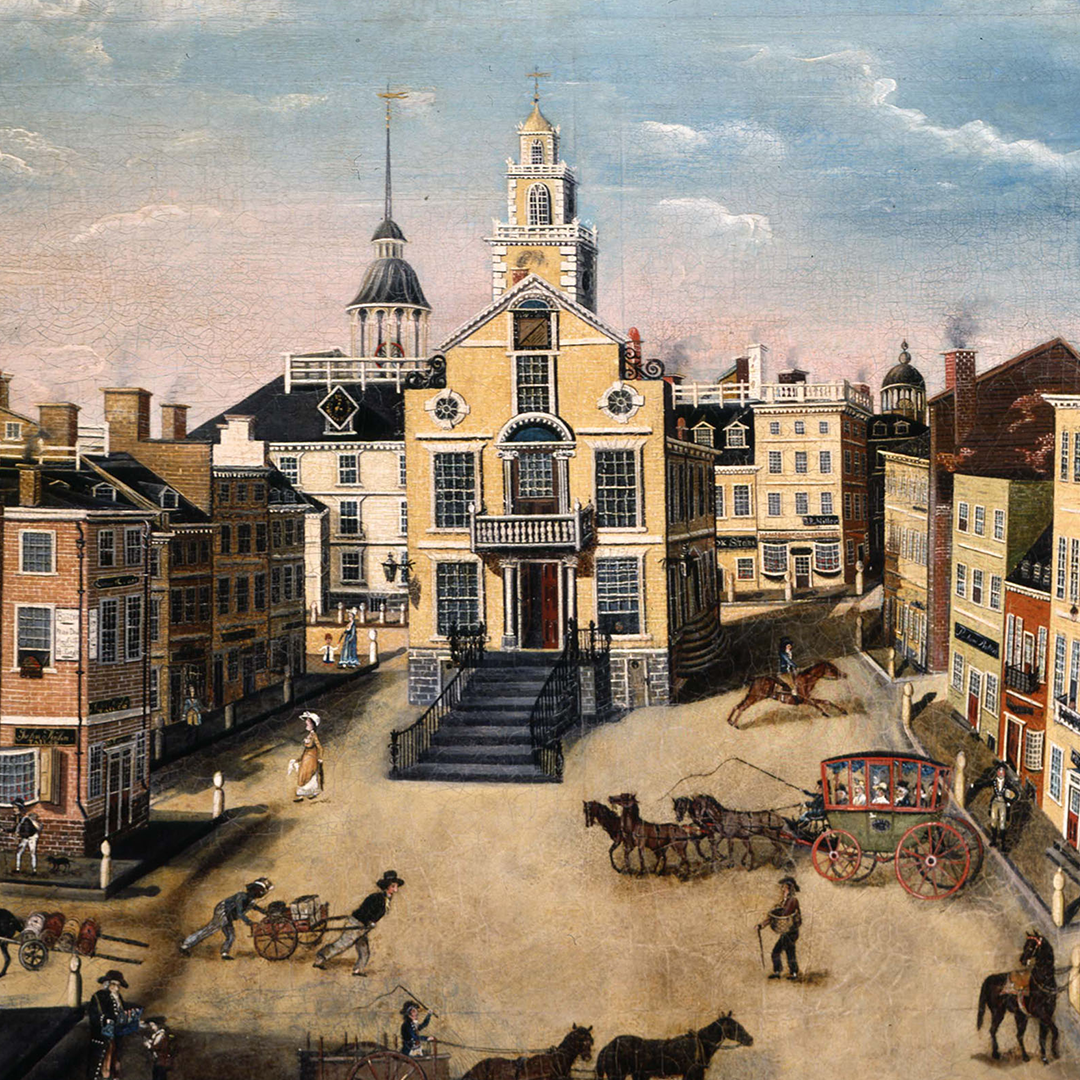
Boston – 1800
 Miles H. Hodges Miles H. Hodges
| | | | |


































